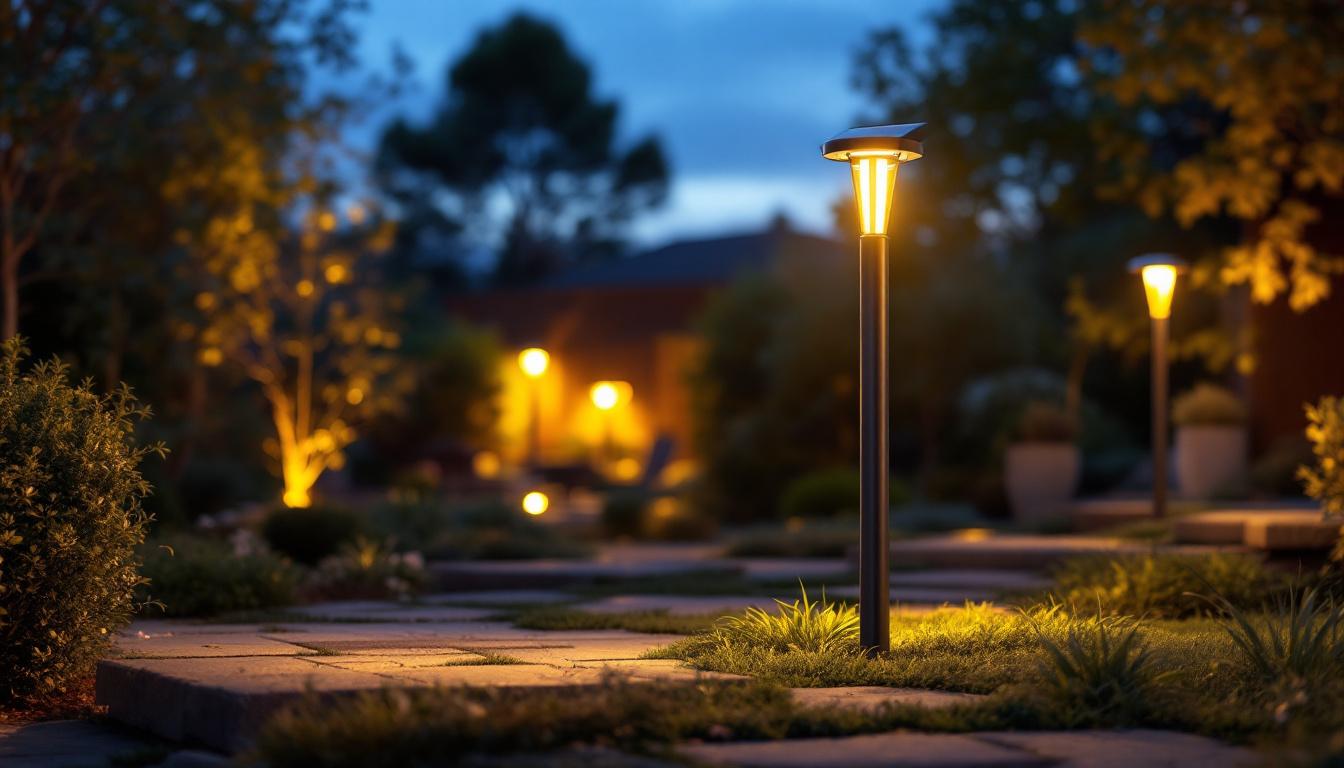
In recent years, the advancement of lighting technology has transformed the way outdoor spaces are illuminated. Among these innovations, motion sensor LED lights have emerged as a leading choice for both residential and commercial applications. This technology not only enhances security but also promotes energy efficiency, making it an attractive option for lighting contractors looking to upgrade their offerings.
As the demand for smart lighting solutions continues to rise, understanding the benefits and applications of motion sensor LED lights becomes crucial. This article explores the future of lighting design and installation, focusing on how motion sensor technology is shaping the landscape.
One of the key advantages of motion sensor LED lights is their ability to conserve energy by only activating when movement is detected. This feature not only reduces electricity costs but also extends the lifespan of the bulbs, as they are not constantly on. For instance, in residential settings, homeowners can benefit from having their outdoor lights turn on automatically when someone approaches, providing both convenience and enhanced safety during nighttime hours. In commercial spaces, such as parking lots and building exteriors, these lights can deter potential intruders, creating a safer environment for employees and customers alike.
Moreover, the integration of smart technology with motion sensor LED lights has opened up new possibilities for automation and control. Many of these systems can be connected to smartphones or home automation hubs, allowing users to customize settings, receive alerts, and monitor activity remotely. This level of control not only enhances user experience but also allows for more sophisticated lighting designs that can adapt to different situations, such as dimming when no motion is detected or brightening when someone is nearby. As technology continues to evolve, the potential applications for motion sensor LED lights are virtually limitless, paving the way for smarter, more efficient lighting solutions in the future.
One of the most significant advantages of motion sensor LED lights is their energy efficiency. Traditional lighting systems often remain on for extended periods, leading to unnecessary energy consumption. In contrast, motion sensor LEDs activate only when movement is detected, substantially reducing energy usage. This feature is particularly beneficial in outdoor settings where lights may otherwise remain idle during late-night hours.
By integrating motion sensors with LED technology, contractors can offer clients a solution that not only cuts down on energy bills but also aligns with sustainable practices. This dual benefit of cost savings and environmental responsibility is increasingly appealing to homeowners and businesses alike.
Security is a primary concern for many property owners, and motion sensor LED lights play a vital role in enhancing safety. The sudden illumination of an area when motion is detected can deter potential intruders and alert homeowners to unusual activity. This proactive approach to security is especially important for outdoor spaces, such as driveways, gardens, and entryways.
Lighting contractors can emphasize this security feature when discussing installation options with clients. By highlighting how motion sensor lights can create a safer environment, contractors can position themselves as knowledgeable professionals who understand the needs of their customers.
Motion sensor LED lights offer unparalleled convenience, automatically turning on and off based on movement. This feature is particularly useful in outdoor settings where users may have their hands full or be preoccupied. Additionally, these lights come in various styles and designs, making them suitable for a wide range of applications—from residential patios to commercial parking lots.
The versatility of motion sensor lights allows contractors to cater to diverse client needs. Whether it’s a homeowner looking to enhance their garden or a business seeking to improve safety in a parking area, the adaptability of this technology can meet various lighting requirements.
Before installing motion sensor LED lights, a thorough site assessment is essential. Contractors should evaluate the area to determine the optimal placement of lights for maximum effectiveness. Factors such as the layout of the space, potential obstructions, and the typical movement patterns of people and vehicles must be considered.
During this assessment, contractors can also identify any specific security concerns that clients may have. By understanding the unique needs of each site, contractors can provide tailored solutions that enhance both functionality and safety.
The market for motion sensor LED lights is vast, with numerous options available. Contractors should familiarize themselves with different products to recommend the best solutions to their clients. Key considerations include the sensor’s detection range, the brightness of the LEDs, and the design aesthetics of the fixtures.
Additionally, contractors should pay attention to the durability and weather resistance of the products they choose. Outdoor lights must withstand various environmental conditions, so selecting high-quality materials is crucial for ensuring longevity and reliability.
Proper wiring and power supply are critical components of any lighting installation. Motion sensor LED lights may require specific wiring configurations, especially if they are integrated with smart home systems. Contractors should ensure that they are familiar with the electrical requirements and local building codes to avoid any compliance issues.
Furthermore, considering energy sources is vital. For remote areas where traditional power sources may not be available, solar-powered motion sensor lights offer an excellent alternative. These systems can provide effective lighting without the need for extensive electrical work, making them an attractive option for many clients.
As technology continues to evolve, the integration of smart systems into outdoor lighting design is becoming increasingly popular. Motion sensor LED lights can now be connected to smart home networks, allowing users to control their outdoor lighting remotely. This capability enhances convenience and offers additional features such as scheduling and customization.
Contractors should stay informed about the latest advancements in smart lighting technology to provide clients with cutting-edge solutions. By offering products that can be integrated with home automation systems, contractors can position themselves as forward-thinking professionals in the lighting industry.
One of the most exciting aspects of smart motion sensor LED lights is the ability for remote monitoring and control. Homeowners can receive notifications on their smartphones when motion is detected, allowing them to stay informed about activity around their property. This feature not only enhances security but also provides peace of mind for those who travel frequently or have second homes.
For contractors, promoting these advanced features can be a significant selling point. Clients are increasingly looking for solutions that offer enhanced control and monitoring capabilities, making smart motion sensor lights an attractive option.
The future of outdoor lighting design is undoubtedly leaning towards smart technology and energy-efficient solutions. As more homeowners and businesses seek to enhance their outdoor spaces, the demand for motion sensor LED lights is expected to grow. Contractors who embrace these trends and adapt their offerings will be well-positioned to succeed in an evolving market.
Emerging technologies, such as artificial intelligence and machine learning, may further enhance the capabilities of motion sensor lights. These advancements could lead to even more sophisticated systems that learn user preferences and adjust lighting accordingly, creating a truly personalized experience.
While motion sensor LED lights offer numerous benefits, there are challenges that contractors must navigate during installation. Environmental factors such as weather conditions, landscaping, and the presence of animals can impact the effectiveness of motion sensors. For instance, heavy rain or snow may obstruct sensors, while nearby trees or shrubs could trigger false alarms.
Contractors should take these factors into account during the planning phase. By strategically placing lights and adjusting sensor sensitivity, they can minimize the impact of environmental variables and ensure optimal performance.
Educating clients about the functionality and benefits of motion sensor LED lights is crucial for successful installation. Many homeowners may be unfamiliar with how these systems work, leading to misconceptions or unrealistic expectations. Contractors should take the time to explain the technology, including how to adjust settings and troubleshoot common issues.
Providing clear communication and guidance can enhance client satisfaction and foster long-term relationships. Happy clients are more likely to recommend contractors to others, helping to build a solid reputation in the industry.
Like any lighting system, motion sensor LED lights require regular maintenance to ensure optimal performance. Contractors should inform clients about the importance of keeping sensors clean and unobstructed, as dirt or debris can hinder functionality. Additionally, discussing the lifespan of LED bulbs and the need for periodic replacements will help clients understand their responsibilities.
By offering maintenance services or reminders, contractors can further establish themselves as trusted partners in the lighting industry. This proactive approach not only enhances client satisfaction but also opens up additional revenue opportunities.
Motion sensor LED lights represent a significant advancement in outdoor lighting design and installation. Their energy efficiency, enhanced security features, and convenience make them an appealing choice for both contractors and clients. As the demand for smart lighting solutions continues to grow, contractors who embrace these technologies will find themselves at the forefront of the industry.
By understanding the benefits, installation considerations, and future trends associated with motion sensor LED lights, contractors can position themselves as knowledgeable professionals capable of meeting the evolving needs of their clients. As the landscape of outdoor lighting continues to change, staying informed and adaptable will be key to success in this dynamic market.
Ready to lead the way in innovative outdoor lighting solutions? At LumenWholesale, we provide contractors like you with the highest quality motion sensor LED lights at unbeatable wholesale prices. Our spec-grade products are designed to meet the highest industry standards, ensuring you deliver reliable and high-performance lighting to your clients. Say goodbye to inflated markups and hello to hassle-free bulk buying with free shipping. Elevate your lighting projects with the perfect blend of quality, affordability, and convenience. Discover wholesale lighting at the best value today and light up the future with confidence.

Explore the science of modern flush mount lighting and discover how it transforms spaces.

Discover essential compliance guidelines for solar LED lamp post lights in this informative article.

Discover the essential guide for lighting contractors on industrial LED spotlights.

Discover essential tips for using RGB can lights effectively and avoid common pitfalls in your lighting projects.